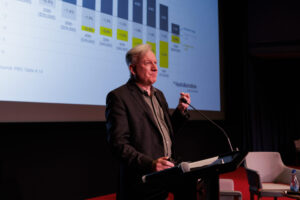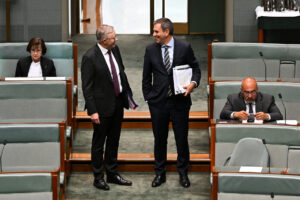by Ebony Bennett
[Originally published by the Canberra Times, 16 May 2020]
This week, the federal government announced Australia’s biggest monthly rise in unemployment since the Australian Bureau of Statistics started publishing labour force statistics, shooting up to 6.2 per cent from 5.2 per cent just a month earlier. But, in a classic case of expectations management, the one percentage point increase was received as good news. After all, hadn’t there been talk of unemployment rates of 10 per cent or 15 per cent? The biggest rise ever, to 6.2 per cent, suddenly seems small by comparison.
It seemed to even surprise the Prime Minister, who said: “While the headline [unemployment] rate is at just over 6 [per cent], when you have almost 600,000 people exit employment that is a devastating set of numbers. And when you look at hours worked and all of those issues as well, what you do see is an even deeper impact.”
So, if unemployment is “only” 6.2 per cent, does this mean that predictions of the biggest economic downturn since the Great Depression are overblown?
Sadly, no. The problem is that a perfect storm of events has resulted in the official unemployment figures massively underestimating the true impact the COVID-19 crisis is having on Australia’s labour market.
Before we reach for our tin foil hats, there is no conspiracy. The ABS hasn’t changed how it calculates unemployment. The government is not trying to hide the truth from you. There are enough conspiracy theories going around at the moment without adding one more.
In fact, the ABS has released more information than usual to try and put the figures in context. The Australia Institute took a closer look and did our own calculations, to get a more realistic unemployment rate.
To start, it’s important to know that the ABS has very strict rules about who is counted as unemployed. You must work zero paid hours to be officially unemployed. If you work just one hour a week, then you count as employed.
You must be actively looking for work. If you would happily take a job if it was offered to you, but didn’t do anything to look for one, then you don’t count as unemployed.
You must also be able to start a job next week, if it was offered to you. So, for example, if you needed to find childcare before starting, and that meant you couldn’t start within a week, then you don’t count as unemployed.
Official unemployment increased by 105,000 last month, but that number doesn’t include people who lost their job and “left the labour market”. That is, people who lost their job but don’t meet the ABS’s strict definition of “unemployed”.
This has shown up as a huge drop in the participation rate, of 2.4 per cent. The participation rate is the proportion of the working age population made up of people that are in work or looking for work. 2.4 per cent in a month is the biggest drop ever recorded. To put that fall in context, the next largest monthly drop was 0.6 per cent, or only a quarter of the current fall.
That means that almost half a million Australians left the labour market. Many of them gave up looking for work.
Why would people do that? Well, when all you see around you are people losing their jobs and lots of people looking for work, the natural reaction, particularly for those who were struggling to find a job before the pandemic hit, is to think you have no chance of finding one. And for those who work in sectors that have largely or completely shut down, there may be simply no work to be found.
Economists call this the “discouraged worker” effect. But really, it’s a mark of despair.
The JobKeeper wage subsidy has also skewed the numbers. This is the $130 billion scheme that the government announced in March. It is paying the equivalent of roughly the minimum wage to 6 million workers employed by firms hit hard by the coronavirus shutdown.
The labour force data collected by the ABS wasn’t designed to account for this kind of wage subsidy. To start with, the ABS actually collects data on hours paid, not hours worked. The ABS assumes that if your boss is paying you, then you must be doing something productive. But because of how the wage subsidy has been designed, there may be many workers who are being paid to do nothing at all – and many others that are being paid to do much less than they normally would.
The ABS estimates that 750,000 people who worked zero hours were counted as employed.
The official number of unemployed is 825,000. If we add the almost 500,000 discouraged workers and the 750,000 who worked zero hours on the JobKeeper wage subsidy, we get a total unemployed of almost 2.1 million. That equals an effective unemployment rate of not 6.2 per cent, but 15 per cent.
Even 15 per cent does not fully reflect what is happening in the labour market. Hours worked fell by more than 9 per cent this month. That means that Australians, on average, worked seven hours less in April than they did in March. The ABS estimates a million Australians worked less hours. Many of those would be on JobKeeper.
These numbers underpin how important government support has been for jobs and for the economy. Without JobKeeper, the unemployment rate would be a lot higher, and without the doubling of unemployment payments, many would be deep in poverty and wondering how they were going to pay the rent or mortgage.
The economy and the jobs market have taken a huge blow. History tells us that unemployment will stay high for a long time to come. While the government may be keen to cut off extra support soon, doing so will not only hurt the recovery but also have a devastating impact on the lives and livelihoods of millions of Australians.
- Ebony Bennett is the deputy director at independent think tank the Australia Institute. Twitter: @ebony_bennett.
Between the Lines Newsletter
The biggest stories and the best analysis from the team at the Australia Institute, delivered to your inbox every fortnight.
You might also like
Stage 3 Better – Revenue Summit 2023
Presented to the Australia Institute’s Revenue Summit 2023, Greg Jericho’s address, “Stage 3 Better” outlines an exciting opportunity for the government to gain electoral ground and deliver better, fairer tax cuts for more Australians.
Richard Denniss: National Press Club Address
On Wednesday, 31 January 2024, Richard Denniss and Allegra Spender MP addressed the National Press Club for a debate on the Stage 3 tax reforms. **Check against delivery** [See below for transcripts] Tax is good. Tax is an investment in our society and the highest taxed countries in the world also happen to be the
RN Breakfast: Redesigning the Stage 3 Tax Cuts
Richard Denniss joins ABC RN Breakfast with Patricia Karvelas to discuss redesigning the Stage 3 tax cuts.


